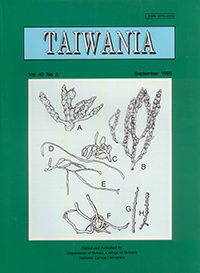Research Paper
Pollen Analysis of the Cretaceous Sediments in Taiwan
Cheng-Long Shaw and Tseng-Chieng Huang
Published on: September 1995
Page: 317 - 352
DOI: 10.6165/tai.1995.40.317
Abstract
Fifty eight form genera, one hundred and thirty four form species of fossil palynomorphs were reported from the early Cretaceous strata based on materials from seventeen exploration wells in Taiwan. Among these, there are fourty-five form genera and ninety eight form species of pteridophytic spores, eleven form genera and twenty six form species of gymnospermous grains, and two form genera and ten form species of angiospermous grains and one form genus and one form species of algal spores. These early Cretaceous palynomorphic assemblages are predominated by gymnosperms in species quantity but by pteridophytes in species diversity. Angiospermous species are only represented by primitive monocolpate and tricolpate pollen grains. The flora assemblages of the early Cretaceous of Taiwan might suggest a tropical to subtropical climate at that time and the plant community was dominated by coastal scrub plants such as Classopollis. More landwards, the flora was replaced by pteridophytic Cyatheaceae and gymnospermous Classopollis savanna plants in which local pteridophytic grassland was also common.
中文摘要
本論文於十七口地下探井,白堊紀早期地層中共發現孢粉話石五十四屬一百二十種,其中蕨類孢子計有四十五屬九十五種,裸子植物花粉計有七屬十九種;被子植物花粉計有二屬六種。由早期白堊紀之孢粉化石群聚,顯示裸子植物花粉為其中顯著的一個組成份子;蕨類孢子種類多趨異性極大亦為其中顯著的植物群;而被子植物花粉僅有單溝及三溝的原始型花粉。於台灣陸海域白堊地層,由其孢粉組合反映當時的氣候均為熱帶到亞熱帶之氣候,其植物社會為由濱海一帶的 Classopollis 為主之灌叢林,逐漸往內陸演替為以蕨類植物桫欏科為主,裸子植物 Classopollis 為輔的灌叢疏林,於林內或林間局部生長著草本的蕨類植物。
Keyword: Cretaceous, Pollen analysis, Taiwan. 台灣,白堊紀,孢粉分析。


